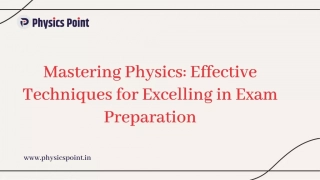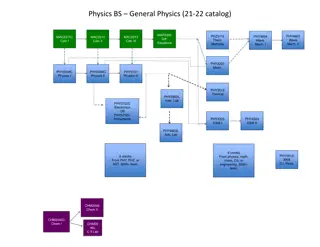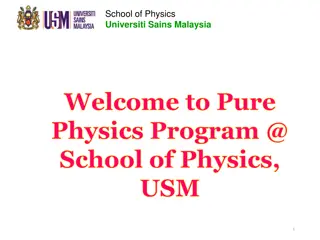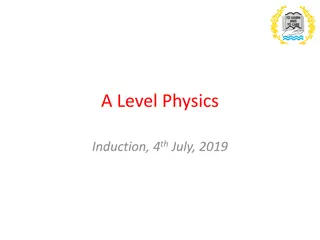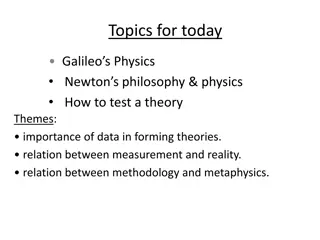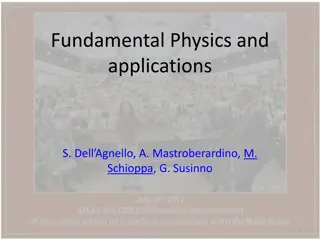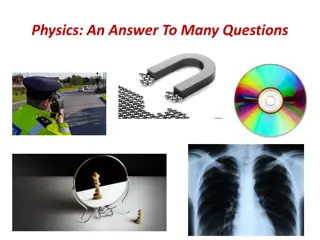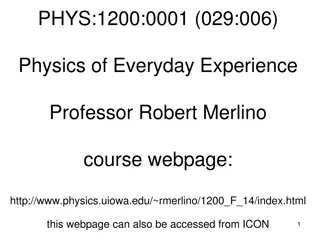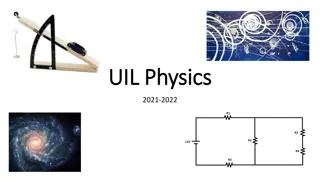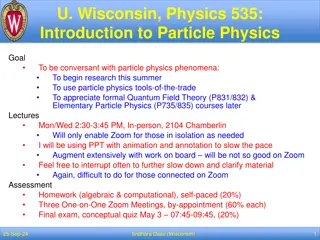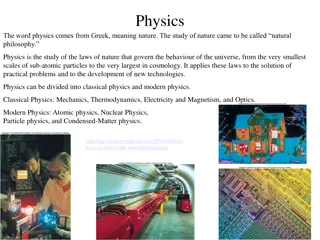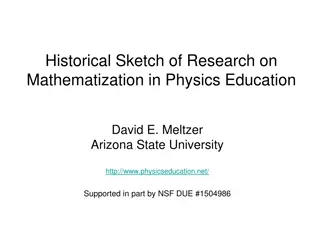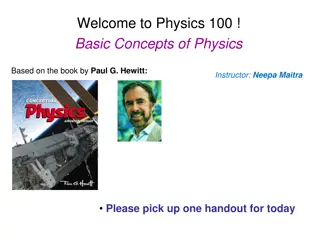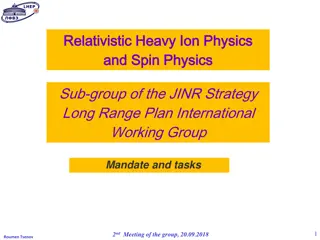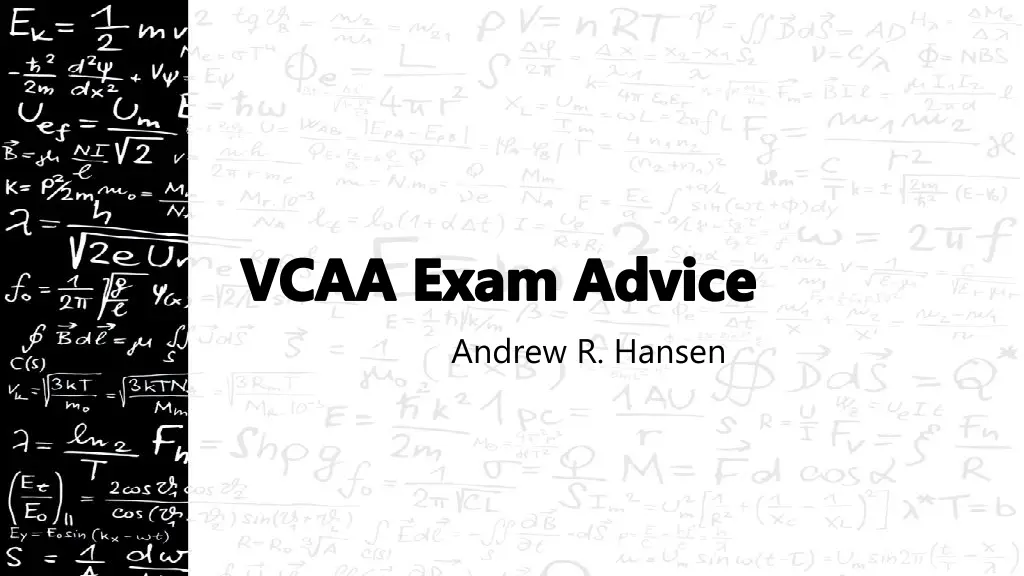
VCAA Exam Assessment and Marking Process Guidelines
Learn about the comprehensive process followed by the VCAA Exam Assessment Team, including the role of Chief Assessors, Senior Markers, and Physics teachers in marking exam papers. Understand the steps involved in the assessment process, meetings, marking guidelines, and resolution of discrepancies to ensure fair evaluation. Discover how final grades are determined and how anomalous grades are addressed. Explore past paper examples and gain insights into the 2019 Physics exam.
Download Presentation

Please find below an Image/Link to download the presentation.
The content on the website is provided AS IS for your information and personal use only. It may not be sold, licensed, or shared on other websites without obtaining consent from the author. If you encounter any issues during the download, it is possible that the publisher has removed the file from their server.
You are allowed to download the files provided on this website for personal or commercial use, subject to the condition that they are used lawfully. All files are the property of their respective owners.
The content on the website is provided AS IS for your information and personal use only. It may not be sold, licensed, or shared on other websites without obtaining consent from the author.
E N D
Presentation Transcript
VCAA Exam Advice Andrew R. Hansen
The Assessment Team Chief Assessor: Three Assistant Chief Assessors: 10-12 Senior markers: Used for resolution marking General markers: Around 100 practicing or retired Physics teachers.
The assessment process Immediately after the exam the CAG meets representatives of the setting panel. The setting panel decide the marks per question and provides a draft marking guide. The CAG decides (initially) how the marks are to be allocated.
Prior to Assessors meeting The CAG meets for a day prior to Assessors meeting for a process called script selection . The CAG develops the training material to be used.
The Assessors meeting Occurs the Saturday following the exam. The marking scheme is discussed and the training papers are completed. The marking scheme is amended. The four trial papers are completed. The marking scheme is finalised and printed / posted.
The marking process Each question is marked (initially) by two markers. Discrepancy results in a third marker. Two most concordant results are used provided they are not still discrepant. This marking is done by CAG and senior markers. Marks that are still discrepant go to adjudication. Done by CAG. Most concordant two marks are used and added for final mark*.
The marking process Final grades that differ significantly from the teacher s indicative grades / GAT / SAC results are declared anomalous. Anomalous grade marking. Done by CAG
2019 PHYSICS EXAM 12 2019 PHYSICS EXAM SECTION B 12 SECTION B Instructions for Section B Instructions for Section B Answer all questions in the spaces provided. Write using blue or black pen. Where an answer box is provided, write your fi nal answer in the box. If an answer box has a unit printed in it, give your answer in that unit. In questions where more than one mark is available, appropriate working must be shown. Unless otherwise indicated, the diagrams in this book are not drawn to scale. Take the value of g to be 9.8 m s 2. Answer all questions in the spaces provided. Write using blue or black pen. Where an answer box is provided, write your fi nal answer in the box. If an answer box has a unit printed in it, give your answer in that unit. In questions where more than one mark is available, appropriate working must be shown. Unless otherwise indicated, the diagrams in this book are not drawn to scale. Take the value of g to be 9.8 m s 2. Question 1 (3 marks) A particle of mass m and charge q travelling at velocity v enters a uniform magnetic fi eld B,as shown in Figure 1. A R E A Question 1 (3 marks) A particle of mass m and charge q travelling at velocity v enters a uniform magnetic fi eld B,as shown in Figure 1. A R E A T H I S T H I S B v B v particle particle I N I N W R I T E W R I T E Figure 1 Figure 1 N O T a. Is the charge q positive or negative? Give a reason for your answer. 1 mark N O T D O a. Is the charge q positive or negative? Give a reason for your answer. 1 mark D O Explain why the path of the particle is an arc of a circle while the particle is in the magnetic fi eld. 2 marks b. Explain why the path of the particle is an arc of a circle while the particle is in the magnetic fi eld. 2 marks b. SECTION B continued SECTION B continued
1/1 1/2
1/1 0/2
2019 PHYSICS EXAM 16 Question 4 (5 marks) Assume that a journey from approximately 2 Earth radii (2RE) down to the centre of Earth is possible. The radius of Earth (RE) is 6.37 106 m. Assume that Earth is a sphere of constant density. A graph of gravitational fi eld strength versus distance from the centre of Earth is shown in Figure 4. gravitational field strength (N kg 1) Y A R E A T H I S distance from the centre of Earth (m) 2RE RE I N Figure 4 What is the numerical value of Y? 1 mark a. W R I T E N kg 1 Explain why gravitational fi eld strength is 0 N kg 1 at the centre of Earth. b. 2 marks N O T D O SECTION B Question 4 continued
1/1 0/2
1/1 0/2
Field strength is given by ? =?? ?2. As r approaches zero, g approaches zero. All the field lines converge at the centre. As there are equal numbers of field lines in each direction the net field strength is zero.
The misconception is probably based on this diagram found in most textbooks.
19 2019 PHYSICS EXAM Question 6 (7 marks) A home owner on a large property creates a backyard entertainment area. The entertainment area has a low-voltage lighting system. To operate correctly, the lighting system requires a voltage of 12 VRMS. The lighting system has a resistance of 12 . a. Calculate the power drawn by the lighting system. 1 mark 19 2019 PHYSICS EXAM Question 6 (7 marks) A home owner on a large property creates a backyard entertainment area. The entertainment area has a low-voltage lighting system. To operate correctly, the lighting system requires a voltage of 12 VRMS. The lighting system has a resistance of 12 . W D ON O TW R I T EI NT H I SA R E A a. To operate the lighting system, the home owner installs an ideal transformer at the house to reduce the voltage from 240 VRMS to 12 VRMS. The home owner then runs a 200 m long heavy-duty outdoor extension lead, which has a total resistance of 3 , from the transformer to the entertainment area. Calculate the power drawn by the lighting system. 1 mark b. The lights are a little dimmer than expected in the entertainment area. Give one possible reason for this and support your answer with calculations. 4 marks W D ON O TW R I T EI NT H I SA R E A To operate the lighting system, the home owner installs an ideal transformer at the house to reduce the voltage from 240 VRMS to 12 VRMS. The home owner then runs a 200 m long heavy-duty outdoor extension lead, which has a total resistance of 3 , from the transformer to the entertainment area. b. The lights are a little dimmer than expected in the entertainment area. Give one possible reason for this and support your answer with calculations. 4 marks c. Using the same equipment, what changes could the home owner make to improve the brightness of the lights? Explain your answer. 2 marks c. Using the same equipment, what changes could the home owner make to improve the brightness of the lights? Explain your answer. 2 marks SECTION B continued TURN OVER SECTION B continued TURN OVER
Students could respond through one of the following lines of argument: a. The power delivered to the lights is less than 12 W. b. The voltage delivered to the lights is less than 12 V. c. The current delivered to the lights is less than 1 A. This then had to be supported by calculations. This required finding the total resistance of the system (which was 12 + 3 = 15 ) and the actual current for the system (which was 12 / (12 + 3) = 0.8 A). Students could then support their assertions as follows: ?????= ?2? = 0.82 3 = 1.92 ? lost in the lead. b. ?????= ?? = 0.8 3 = 2.4 ? lost over the lead. c. ?????????= 1?.??????????= 0.8 ? a.
2019 PHYSICS EXAM 36 Question 17 (7 marks) Students are comparing the diffraction patterns produced by electrons and X-rays, in which the same spacing of bands is observed in the patterns, as shown schematically in Figure 18. Note that both patterns shown are to the same scale. A R E A electrons X-rays T H I S Figure 18 The electron diffraction pattern is produced by 3.0 103 eV electrons. Explain why electrons can produce the same spacing of bands in a diffraction pattern as X-rays. 3 marks a. I N W R I T E N O T Calculate the frequency of X-rays that would produce the same spacing of bands in a diffraction pattern as for the electrons. Show your working. b. 4 marks D O Hz SECTION B continued
General advice Always show working. Allow markers to exercise reward good physics clause. 2019 PHYSICS EXAM 12 SECTION B Instructions for Section B Answer all questions in the spaces provided. Write using blue or black pen. Where an answer box is provided, write your fi nal answer in the box. If an answer box has a unit printed in it, give your answer in that unit. In questions where more than one mark is available, appropriate working must be shown. Unless otherwise indicated, the diagrams in this book are not drawn to scale. Take the value of g to be 9.8 m s 2. Question 1 (3 marks) A particle of mass m and charge q travelling at velocity v enters a uniform magnetic fi eld B,as shown in Figure 1. A R E A T H I S B v particle I N W R I T E Figure 1 N O T a. Is the charge q positive or negative? Give a reason for your answer. 1 mark D O Explain why the path of the particle is an arc of a circle while the particle is in the magnetic fi eld. 2 marks b. SECTION B continued
General advice Avoid algebraic rearrangement. Make it easier for markers to award the formula & substitution mark(s). Answers in decimals with appropriate sig figs. No surds and no excessive decimal places.
General advice Layout & legibility. Markers are not obliged to mark illegible responses. The onus is on the student to make their understanding clear, not on the assessor to assume the student s understanding. Calculators. Use the exponent key. Check mode (degrees, not radians).
Short answer questions Keep them short!!! Stay within the space provided. Use dot points. My model: What is the answer? What physics is being used? How does that physics apply?
Final words Read the Chief Examiner s Report s. Know where the opposition is weak. Do lots of practice papers. Keep an eye on the time. Have a strategy for catching silly mistakes.
VCAA Exam Advice Andrew R. Hansen

